“Blip, blip, bleeep, blip!”
No, you’re not listening to the sounds of a sonar as it discovers an enemy submarine tracking you, it’s just the sound of a Tiger. A Tiger LCD game, to be exact. Those low-price, low-quality electronic games from the Seventies all the way up to the Nineties that somehow managed to get into almost every child’s hands, despite being utter trash when you actually played them.
Where did these things come from? How did they manage to become so successful? Today we are going to try to answer that.
The Early History
Formed in 1978, Tiger initially stayed away from electronic gaming and focussed on other electronics products such as the Kiss Phono; a record player with Kiss branding on it.
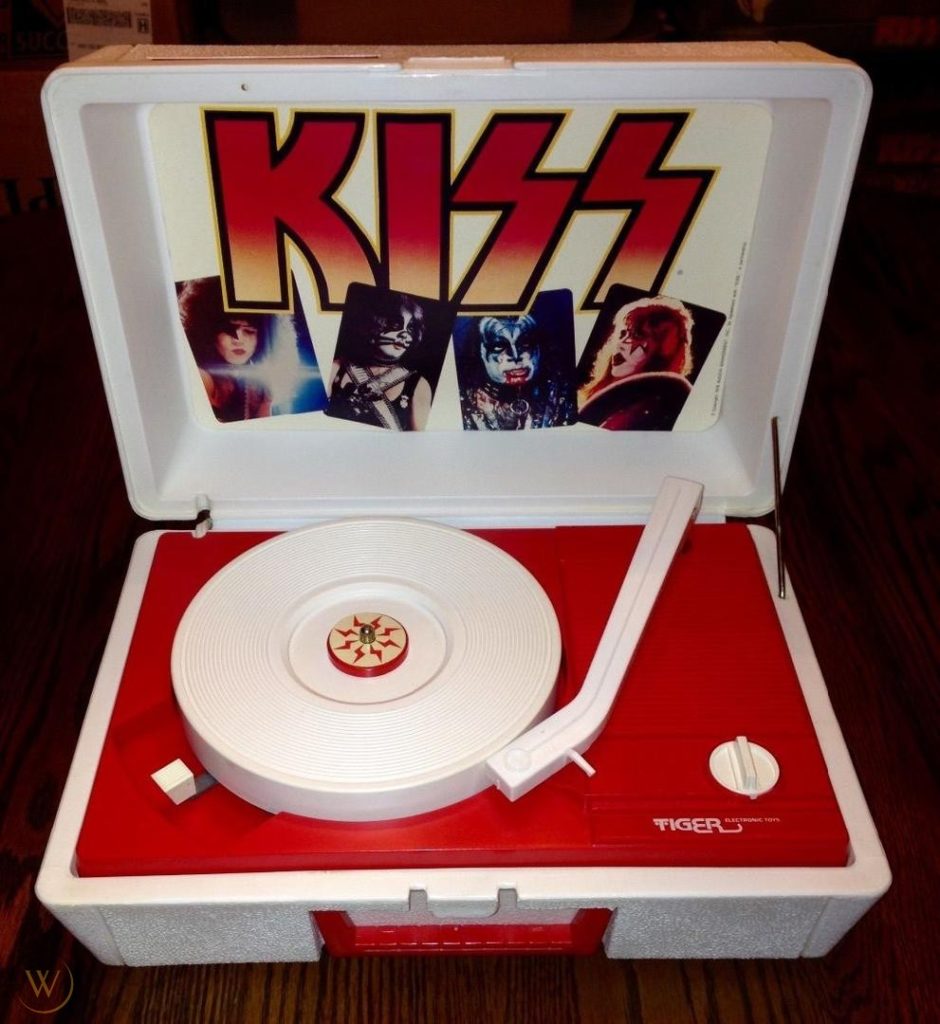
Sadly, this was not to last and the company would achieve amazing success when they started bringing out low-grade electronic gaming to capitalise on the emerging craze for video games.
The LCD games would become the powerhouse line for the fledgling company, keeping them afloat when their other insane ideas could easily have bankrupted them.
That wouldn’t stop Tiger from producing wacky product after wacky product, of course. They just had a much-needed buffer to prevent them going under when their latest moronic product, such as a pen that’s also an electronic organiser (no, that’s not a joke), failed to set the world on fire.
Launch of the LCD games
The first Tiger LCD games arrived in 1985, with Bowling being their initial release. This established the blocky Tiger case design where the LCD screen was sat in the centre of the top half and two sets of controls would be placed on the lower portion; one set on the left and one set on the right. It’s a design that would stick with the games until the end, although the squared case with sharp edges would be re-modelled in 1988 to have smoother corners.
Despite Tiger’s mass-produced nature, their handheld games weren’t entirely cut-and-paste affairs in the design department. The individual games would all have separate control schemes, so only the backs of the cases were interchangeable. The front casing was specifically modelled for the game in question; with different control schemes tailored specifically for each game. Some had multiple buttons on each side, some had one giant button on one side. The complexity varied but nothing ever got too difficult to work out, even without a manual (and yes, they did come with a manual, just in case you couldn’t figure out the four buttons on your own).
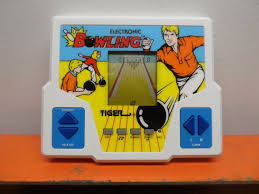
Bowling was quickly followed by more sports titles such as Soccer, Boxing and Golf but Tiger would really find their niche when they started licencing popular franchises such as He-Man, Thundercats, Voltron and Transformers. These games, all released in 1985, showed just how quickly Tiger could go from acquiring a licence to pumping out utter trash games with that licence plastered on it.
Tiger’s success really comes down to two things: they had recognisable names on their products, and they were relatively cheap. Tiger games cost $20 at most, while handheld games usually retailed for $30 or more and console games were higher still. You could pick up older Tiger games for a lot less, of course. This meant that Tiger’s products were always available to kids with a little pocket money but not enough saved for a big-name game; and they made perfect last-minute gifts when you forgot to get something for the kid whose birthday party you were going to drop your children off at.
Tiger would continue to licence popular films and TV shows alongside their sports and in-house designed games until they were acquired by Hasbro in the late Nineties. They even partnered up with Sega and Nintendo to produce LCD tie-in games to accompany those companies’ console games. That’s right, you could get an LCD version of a proper game that you might actually want to play! It was madness.
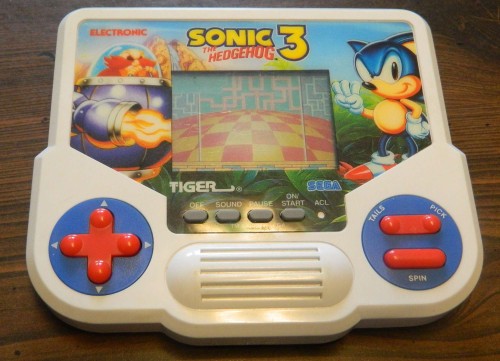
The first year of production saw twelve Tiger LCD games released. Their most productive year was 1994, when they released 17 new games; while their slowest year was 1996, when only four games were produced. Their final LCD title, Rocket Power, was released in 2000 (because apparently it’s possible to go for 25 years selling the same cheap electronic crap over and over again).
Tiger’s LCD gaming division lasted for a quarter of a century, churning out basic game after basic game, but these handheld delights wouldn’t be the only market Tiger would give a try. After Nintendo went into the 3D world of Virtual Reality, you can bet Tiger wanted to give that a try.
Naturally, they screwed it up but they tried anyway, so let’s take a look at just how ridiculously they did it.
The R-Zone
Imagine a world where it’s not enough to just hold an LCD game in your hands when playing. Imagine a world where you hold a controller but the screen is strapped to your head and you see the game through a low-powered, red-on-black LCD screen that’s reflected on some cheap plastic.
Welcome to the world of… The R-Zone.
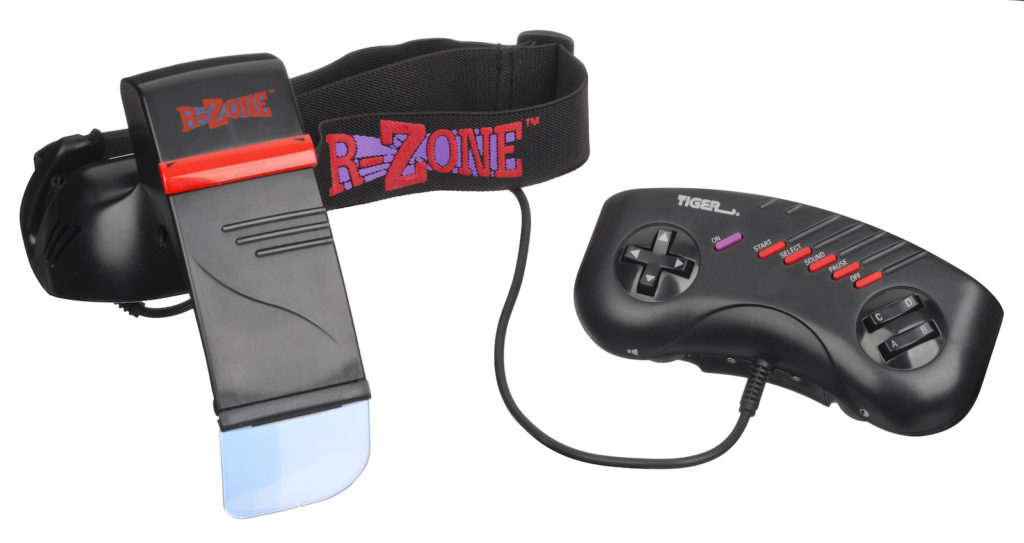
The R-Zone is just a Tiger LCD game in a different shape. The controller houses the majority of the important electronics and it features a set of buttons that function in different ways for different games. The headset contains the cartridge slot and a projector. The actual game screen is on the cartridge, which is where all the information on how the game will play will also be stored.
You slot the cartridge into the headset and you’re good to go (and by “good”, we mean “doomed”). If you look at the game cartridge in the right light, you can see that all the LCD graphics are back-to-front in it and that’s because the light from the R-Zone headset shines through it, projecting the game onto the visor screen via reflection.
The R-Zone was first produced in 1995, ten years after Tiger had entered the gaming world, but it used the same technology as always and it wasn’t a big success. Nevertheless it was popular enough for two R-Zone variants to be produced. The first was the R-Zone X.P.G. (which apparently stands for “Xtreme Pocket Game” although how anyone could fit this thing in their pocket is a question we don’t ever expect anyone to be able to answer). It was a handheld console that still projected the game onto a plastic screen; although this time it was a screen attached to the console itself.
The second, and seemingly far more rare, variant was the R-Zone SuperScreen. This console featured a built-in magnified screen that let you see the LCD graphics at a larger size than you would be able to with the XPG or the original R-Zone. To be fair, Tiger’s graphics were usually rather good (the Enterprise-D in their Star Trek: The Next Generation is beautifully drawn, for example) so maybe this version would have been fun to look at (but not to play. Never to play).
Finally, there was a variant on the variant, because this is Tiger we are talking about and they just don’t know when to quit. From the company that once put an organiser in a pen comes the R-Zone DataZone (yes, the word “Zone” appears twice in the title).
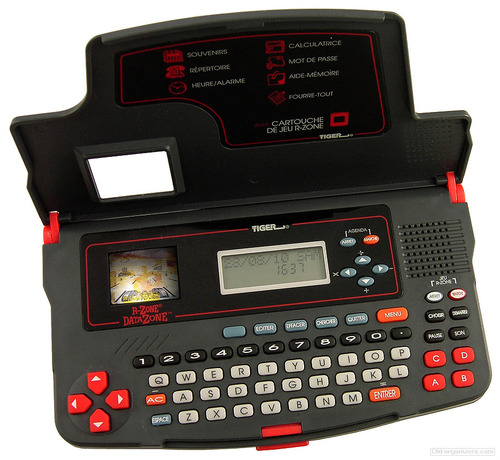
It’s a flatter R-Zone XPG with a flip-up lid that hides a keyboard and organiser screen underneath. Basically, if you take a standard personal organiser from the Nineties and stuck a Game & Watch onto it, you would have the R-Zone DataZone (plus both a better organiser and a better game to play). Who is this thing for? What kid needs a personal organiser, and what adult needs a crap game? This is a problem disguised as a solution and it’s seeking a problem to solve. It serves no purpose other than to look crap and take up space. Which pretty much sums-up Tiger’s entire business model, to be honest.
Tiger produced almost thirty R-Zone cartridges, each of which could be played in any of the variant consoles, and we can’t stress enough how much you really shouldn’t play them.
The End of An Era
Tiger ceased development of its LCD games in 2000, two years after the company had merged with Hasbro. It signalled the end of twenty-five years of using the same very basic LCD system you could find in the average cheap watch to produce average, cheap games. In total, Tiger produced 169 titles, covering everything from sports to first person shooters (they created a version of Doom in 1996).
Tiger still exists as a subsidiary of Hasbro but no longer produces the electronic games they are most famous for. Now they create things like the iDog; which is somehow even more creepy than their infamous Furby. It’s a long way from their golden age; and whether that’s a good thing or not is up to you to decide.
Still, if you just can’t get enough of these awful old games, do not despair! Many of them are available to play online now via the Internet Archive and you can revisit their atrocious glory days by heading over to Handheld History at archive.org right now.
